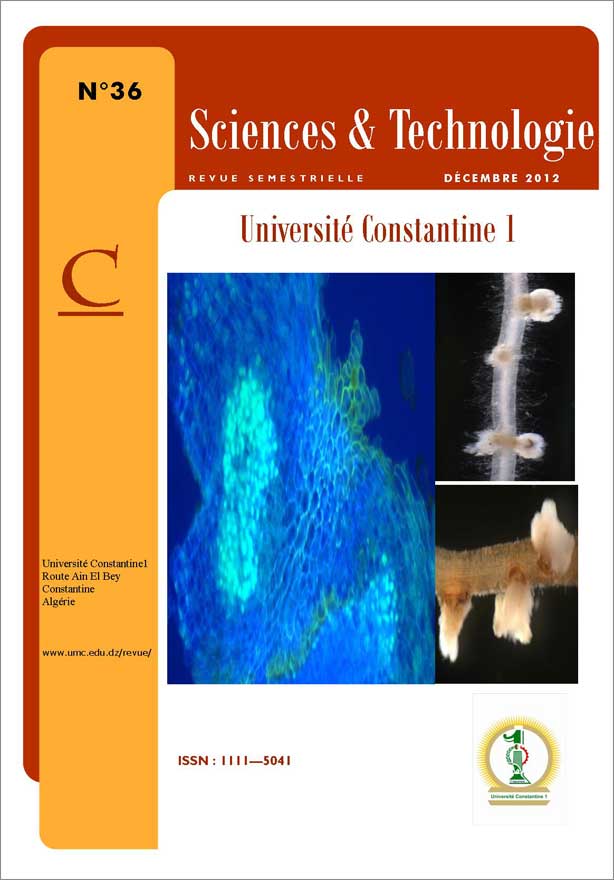EFFECT OF 2, 4-DICHLOROPHENOXYACETATE ON THE FORMATION OF PARANODULES ROOT IN DURUM WHEAT (Triticum durum Desf.) INOCULATED WITH Azospirillum brasilense ISOLATED IN RHIZOSPHERE OF WHEAT IN ALGERIA
Keywords:
Azospirillum, Durum wheat (Triticum durum Desf), Para-nodules, YieldAbstract
Several studies have shown that PGPR have beneficial effects on plants, these rhizobacteria may provide the plant with nitrogen as ammonium by their associations with legumes and some grasses. The strains of Azospirillum brasilense isolated before in rhizosphere of durum wheat, these strains can fix nitrogen improved by nitrogen content in leaves and total chlorophyll. The strains can colonized the durum wheat roots (Triticum durum Desf.) inocultated by formation of paranodules in roots induced by 2.4-D.These bacteria have also effect to improve growth yield these result was obtained by determination of thousand seeds weight.References
Kennedy, I.R, and Y.T.Tchan.1992. Biological nitrogen fixation in non-leguminous field crops:recent advances.Plant Soil 141:93-118.
Ivan R.Kennedy,Lily L.Pereg-Grek,Graig Wood,Rosalind Deaker,Kate Glichrist and Sunietha Katupitiya,2006.Biological nitrogen fixation in nonleguminous field corps:facilitating the evolution of an effective association between Azospirillum and wheat.SUNFix Centre for Nitrogen
Fixation,Departement of Agricultural Chemistry and soil Science,University of Sydney,NSW,Australia.
Christisen-weniger C, Vanderleyden J, 1994. Ammonium-excreting Azospirillum sp.become intracellularly established in maize (Zea mays)
paranodules.Biol.fertil.soils 17:1-8.
Glagoleva OB, Kovalskaya NU, Umarov MM, 1996. Endosymbiosis formation between nitrogen-fixing bacteria pseudomonas caryophylli and rape root cells.Endocytobiosis,Cell Res.11(2/3).
Hardy RWF, Hilsten RD, Jackson EK, Burms RC, 1968. The acetylene assay for nitrogen fixation.Laboratory and field evaluation.Plant Physiol.43:1195-1207.
Fischer S ; Sandra I. Fischer et al,2007. Isolation and characterization of bacteria from the rhizosphere of wheat.World J Microbiol Biotechnol 23:895–903
B.E.BACA and C.Elmerich,2007. Chapter 6: Microbial Production of Plant Hormones.C.Elmerich and W.E.Newton(eds).Associative and Endophytic Nitrogen-fixing Bacteria and Cyanobacterial Associations,113-143.
N. Narula, A. Deubel, W. Gans, R.K. et al ;2006. Paranodules and colonization of wheat roots by phytohormone producing bacteria in soil. Plant soil environment. 52, (3): 119–129.
Katupitiya S, Millet J, Vesk M, Viccars L, Zeman A, Lidong Z, Elmerich C and Kennedy I, 1995. A mutant of Azospirillum brasilense Sp7 impaired in flocculation with a modified colonization pattern and superior nitrogen fixation in association with wheat. Appl. Environ. Microbiol. 61, 1987–1995.
Shakirov Zair Saatovich,2006. Azospirilli of Uzbekistan soils and their influence on growth and development of wheat plants .Plant and Soil 283:137–145
Gough,C et al.1997.Interaction between Bacterial diazotrophs and the non-legume Dicot Arabidopsis thaliana as model plant,Plant soil,Vol 194, nos1-2,pp.123-130.
Nie,Y;E ,Vesk,M.Kennedy, et al,.1992.Structure of 2,4-D induced Paranodules with Rhizobium on wheat.Phytochemistry,no.11,pp:67-73.
Chen,W.,Xie,Y and Chan,T,.1995.Studies on paranodules of wheat and nitrogen fixation,Abster.10th Int congr on Nitrogen Fixation, St.Petersburg.pp:358
Fischer S , Rivarola V, Mori GB. 2000.Colonization of wheat by Azospirillum brasilense Cd is impaired by saline stress. Plant Soil 225:187–191.
Azlin C O, Amir H G and Chan L K. (2005). Isolation and characterization of diazotrophic rhizobacteria from oil palm roots. Malaysian Journal of Microbiology 1: 32–36.
Luquet, D., Begue, A., Vidal, A., Clouvel, P., Dauzat, J., Olioso, A., Gu, X. F., and Tao, Y. 2003. Using multidirectional thermography to characterize water status of cotton. Remote Sensing of Environment , Vol.
, No. 3, pp. 411-421.
Sertsu,S and T.Bekele,2000. Procedures for soil and plant analysis.Ethiopian Agricultural Reaserch organization,Addis Ababa,Ethiopia.
Zeman, A.M.M., Y.T. Tchan, C. Elmerich and I.R.Kennedy, 1992. Nitrogenase activity in wheat seedlings bearing para-nodules induced by 2,4-D and inoculated with Azospirillum. Res.Microbiol., Institute Pasteur Elsevier.143: 847-855.
Hamon M., Pellerin F., Guenet M. et Maauzier G. 1990. Abréges chimie analytique.Méthodes spectrales et analyse organique. Tome 3. 2eme édition. Masson. Paris. p: 232-233.
Alexander G, Rohr R and Bally R 1999 .A phase variant of Azospirillum lipoferum lacks a polar flagellum and constitutively expresses
mechanosensing lateral flagella. Appl. Environ.Microbiol. 65(10), 4701–4704.
Lily Pereg Grek, Kate Gilchrist, and Ivan R.Kennedy,2000. Mutants with Enhanced nitrogenase activity in hydroponic Azospirillum brasilense-wheat Associations.Applied and environmental Microbiology.p.2175-2184.
Francisco Jr.PB, Akao S,1993.2,4-D induced wheat paranodules are modified lateral roots with structures enhanced by rhizobial inoculation.Plant soil,157:121-129.
Reynders L, Vlassak K, 1992. Use of Azospirillum brasilense as biofertilizer in intensive wheat cropping. Plant Soil 66:217-273.
Christisen-weniger ,1993. Ammonium-excreting Azospirillum sp.become intracellularly established in maize (Zea mays) paranodules.Biol.fertil.soils 17:1-8.
Fallik E,Okon Y, 1996. Inoculants of Azospirillum brasilence: biomass production, survival and growth promotion of Seteria italic and Zea mays. Soil Biol.Biochem.28:123-126.
Malik KA, Bilal R, Mehnaz S, et al,1997. Association of nitrogen fixing,plant growth promoting Rhizobacteria (PGPR) with Kallar grass and rice.Plant Soil 194:37-44.
Kapulnik Y, Sarig S, Nur I, Okon Y, 1983. Effect of Azospirillum inoculation on yield of field-grown wheat.Can.J.Microbiol.29:895-899.
Weber OB, Baldani VLD, Teixeira KRS, et al, 1999. Isolation and characterization of diazotrophs from banana and pineapple plants.Plant Soil 210:103-113.
Dobbelaere S, Croomenborghs A, Thys A, Ptacek D, et al, 2001.Responses of agronomically important crops to inoculation with Azospirillum.Aust.J.Plant Physiol.28:871-879.
Okon Y, Kapulnik Y, 1986. Development and functions of Azospirillum inoculated roots.Plant Soil 90:3-16.
Murty MG, Ladha JK, 1988. Influence of Azospirillum inoculation on the mineral uptake and growth of rice under hydroponic conditions.Plant Soil 108:281-285.
Zavalin AA, Kandaurova TM, Vinogradova LV, 1998. Influence of nitrogen fixing microorganisms on the nutrition and productivity of spring wheat, and on the characteristics of photosynthesis of different varieties
of spring wheat. In ElmerichC,Kondorosi A, Newton WE,eds. Biological Nitrogen Fixation for the 21st century. Dordrecht, The Netherlands: Kluwer
Academic Publishers,413-414.
Saubidet MI, Fatta N, Barneix AJ, 2000. The effects of inoculation with Azospirillum brasilense on growth and nitrogen utilization by wheat plants.Plant Soil 245:215-222.

